16. Piedmont: Usseaux, Torre Pellice, Vernante and Camo
Our journey starts in the Piedmont region, where we found no less than four painted villages.
Our first stop is Usseaux (in the province of Turin), a small mountain village in Alta Val Chisone, located at an altitude of 1416 metres and within the Orsiera Rocciavrè Natural Park. Its cobbled streets have no less than 40 murals depicting the village's rural life, nature, inhabitants and fairytale characters.
From here, we move on to the Pellice Valley and, more precisely, to Torre Pellice (Turin). Together with the town of Pinerolo, this is one of the places where held the Street Alps Festival, the first street art festival in Italy set in foothill locations. Here you can admire works by writers of the calibre of Fabio Petani, Riccardo Ten Colombo, Martina Merlini and Derek Bruno.
We leave Torre Pellice and move on to Vernante (in the province of Cuneo), a village in the upper Vermenagna Valley. Entirely dedicated to Pinocchio and its famous illustrator, Attilio Mussino, who spent his last years of life here. The streets and buildings of Vernante are whole with reproductions of the illustrations of Collodi's Pinocchio from 1911.
Our last Piedmontese stop to discover graffiti is Camo (Cuneo), in the heart of the Langhe. A village of 185 inhabitants is home to an interesting contemporary art project: the Camo Open-Air Museum, born as an artist residency project that, since 2013, has hosted dozens of street artists.

15. Lombardy: Arcumeggia and Val Camonica
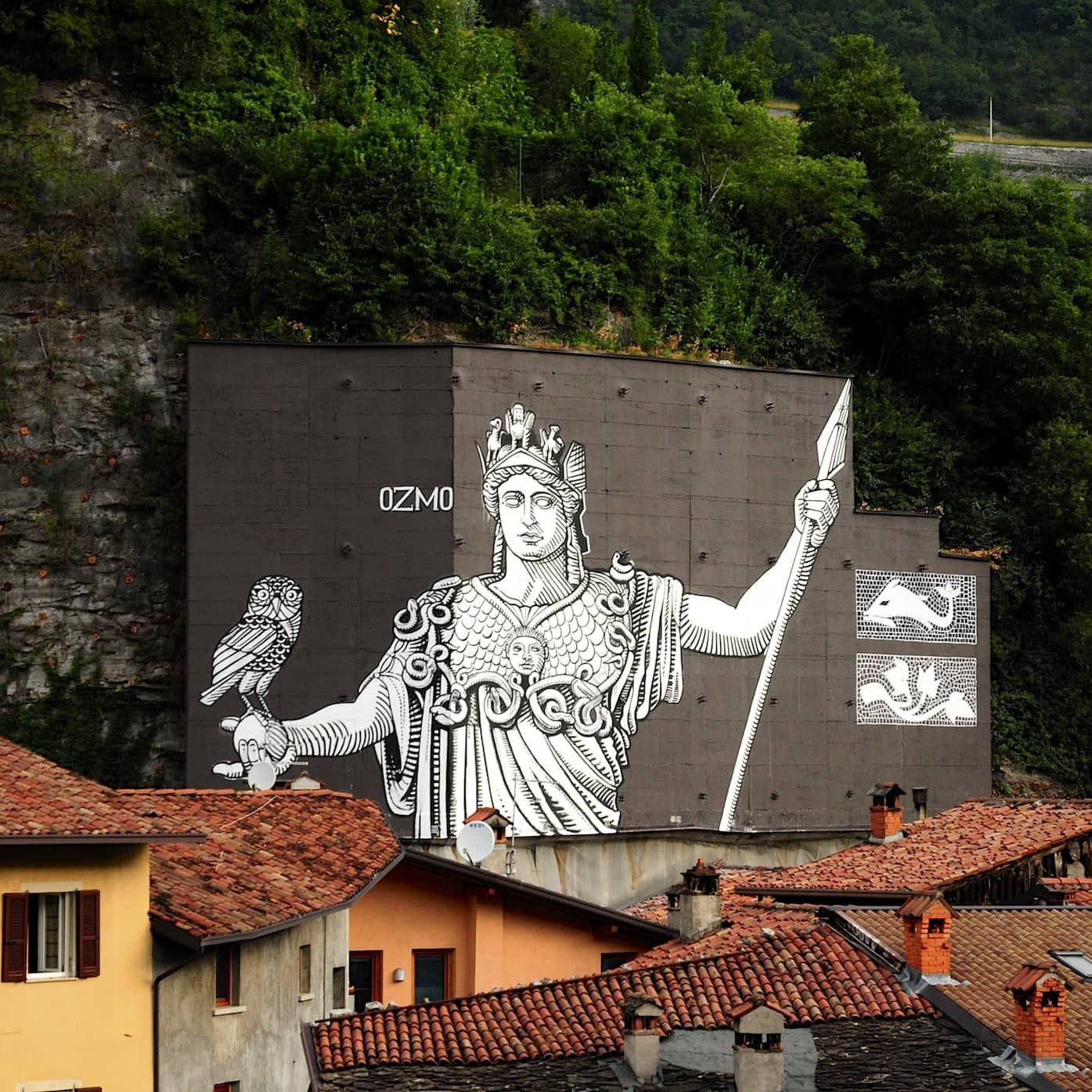
We leave Piedmont for Lombardy. The first stop on our journey at the pace of colours is Arcumeggia (in the province of Varese): this is the first painted village in Italy, the first open-air gallery founded in 1956. There are 168 paintings around the town, created over the years by internationally renowned artists.
And if Arcumeggia is the first painted village, we cannot leave the region without visiting the cradle of artistic expression in murals. We are talking about Valle Camonica (in the province of Bergamo), where a treasure trove of more than 250,000 prehistoric rock engravings, becoming a UNESCO World Heritage Site in 1979.
The Distretto Culturale Della Valle wanted to create a past and contemporary art continuum. In 2015, it launched the project Wall in Art - Walls of Art in the Valley of Signs. Thanks to the visionary Tuscan street artist Ozmo, various wall painters have intervened on the walls made available by the Valley's municipalities, creating a widespread park of public art.
14. Veneto: Cibiana di Cadore
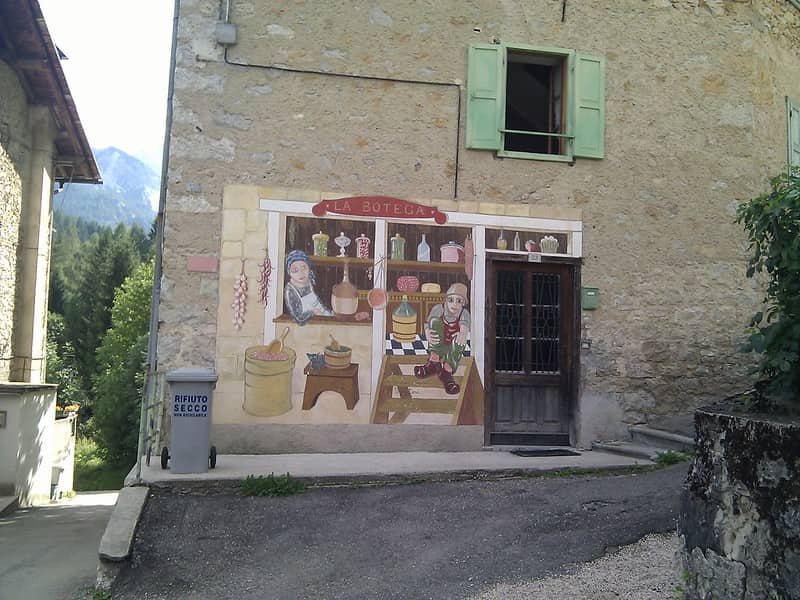
In Veneto, Cibiana di Cadore is a village in the province of Belluno whose walls tell its story. Some fifty murals celebrate the village's ancient tradition and history.
Over the years, word has spread about these murals increasing in number year by year, bringing it to the attention of international artists, who have come here even from Japan and the former Soviet Union.
13. Emilia-Romagna: Molinella, Dozza, Trinità and Vedriano
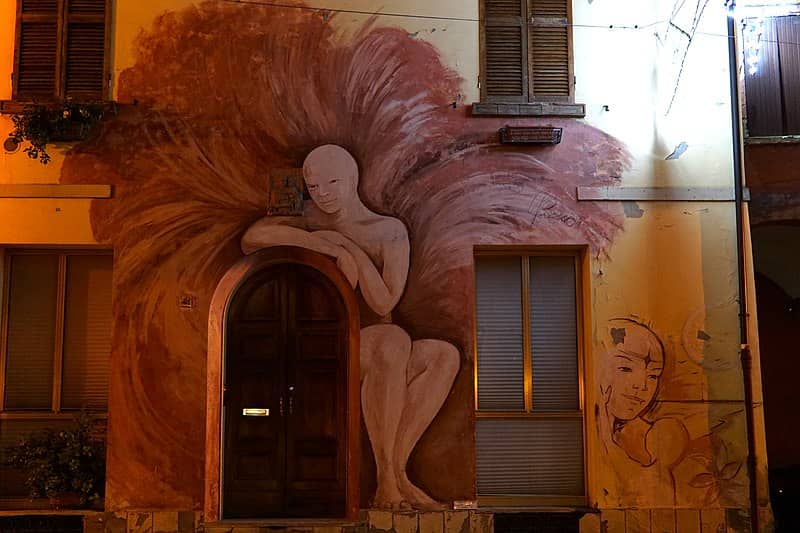
Emilia-Romagna is a region you absolutely must visit if you are a graffiti fan. We visited the villages of Molinella, Dozza, Trinità and Vedriano.
Molinella is a small town between Bologna and Ferrara. Thanks to the ArtU Festival, it has become an exciting destination for urban art lovers: many street artists have painted its walls, telling the story of the place.
Between Bologna and Imola, on the other hand, we find the murals of Dozza, among the most famous and photographed in Italy. This medieval village is home to more than a hundred paintings by great international artists, renewed every year thanks to the "Muro Dipinto" Biennial Exhibition of Contemporary Art.
Finally, we move on to the Reggio Apennines, where the rural villages of Trinità and Vedriano (in the province of Reggio Emilia) are. They host the Street Art Festival, which has enhanced the combination of art and nature, creating a solid bond with the local people.
12. Liguria: Valloria, hamlet of Prelà

In Prelà (in the province of Imperia), there is a small village of only 34 inhabitants called Valloria, known as the village of painted doors. These doors, painted by artists of international renown, adorn the tiny stone houses typical of this medieval village that you will encounter while walking through its narrow alleys.
This initiative comes to life thanks to the event "Valloria fa baldoria" - Valloria revelries, which every year brings three more or less famous painters to create live works on three new doors in the village.
11. Tuscany: Castagno di Piteccio

Castagno di Piteccio is a small village of 80 inhabitants in Pistoia, an open-air museum with more than 40 works. The idea came from the art critic and essayist Tommaso Paloscia, who began to frequent the village as a holiday resort. In the 1970s, he started inviting painters and sculptors to create works in the town.
Today, the village of Castagno di Piteccio is home to dozens of works of art, and, in recent years, artists' residencies have been created, bringing new works of urban art to the village.
10. Latium: Sant’Angelo Roccalvecce and Rocca di Papa
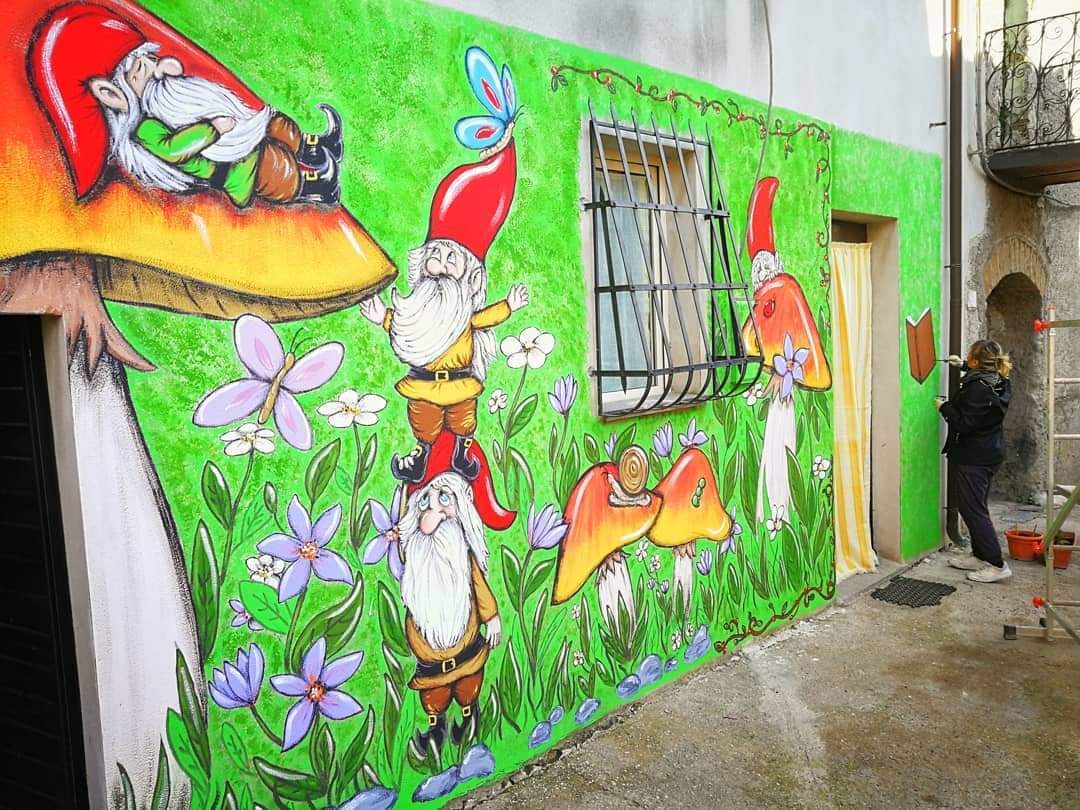
In Lazio, in the heart of the Tuscia Viterbese, stands Sant'Angelo di Roccalvecce, also known as Il Paese Delle Fiabe (Fairy Tale Town). It is a small village that since 2017 has come back to life thanks to murals, installations and mosaics that have decorated the town's walls with drawings dedicated to fairy tales and legends. The creation was entrusted to a team of only female street artists, among the most famous on the Italian scene.
Moving closer to Rome, another small village that has become a veritable open-air museum is Rocca di Papa. Thanks to the local painter Miro Fondi, who began filling the historic centre with murals in the 1980s. Other masters of art, friends of the painter, contributed to the rebirth and growth of the village by creating other works that you will come across as you walk through the alleys of the centre.
9. Marche: Braccano and Gradara
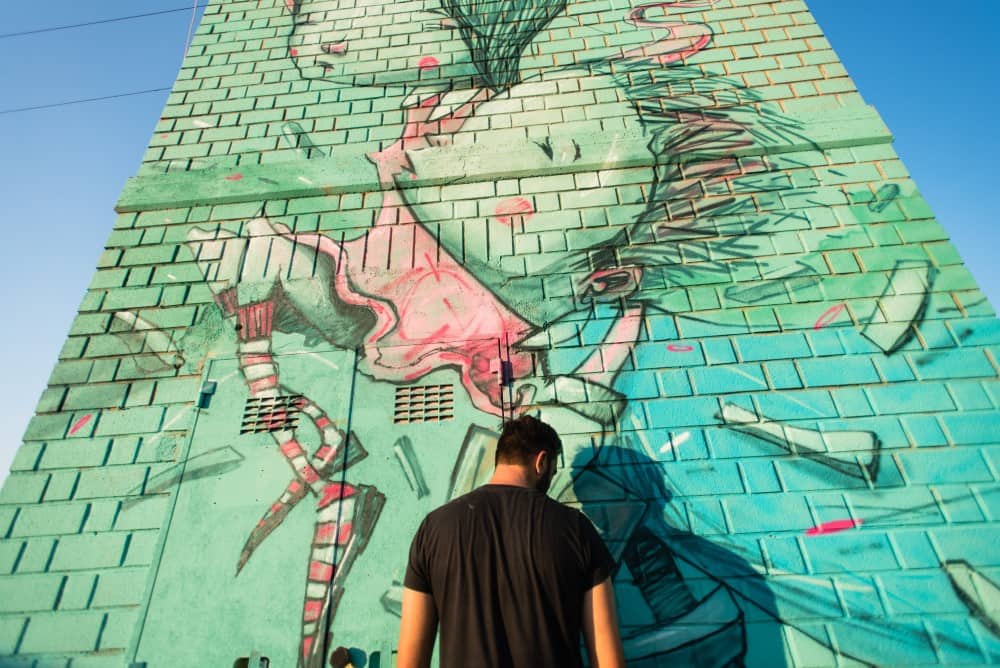
In the province of Macerata, on the western slope of Monte San Vicino, immersed in a beautiful landscape, is Braccano, a small village with just over 150 inhabitants. A hamlet of Matelica, it is worth stopping here to admire the murals that colour the historic centre. They were created by students from the Brera and Macerata Academies, with artists worldwide.
Let's stay in the Marche region and head for Gradara (in the province of Pesaro and Urbino). The Oltre le Mura (Beyond the Walls) project was born, with the ambitious aim of bringing street art to the town, telling the love story of Paolo and Francesca (said in Dante's Divine Comedy) in a contemporary language.
8. Abruzzo: the Medieval hamlet of Aielli
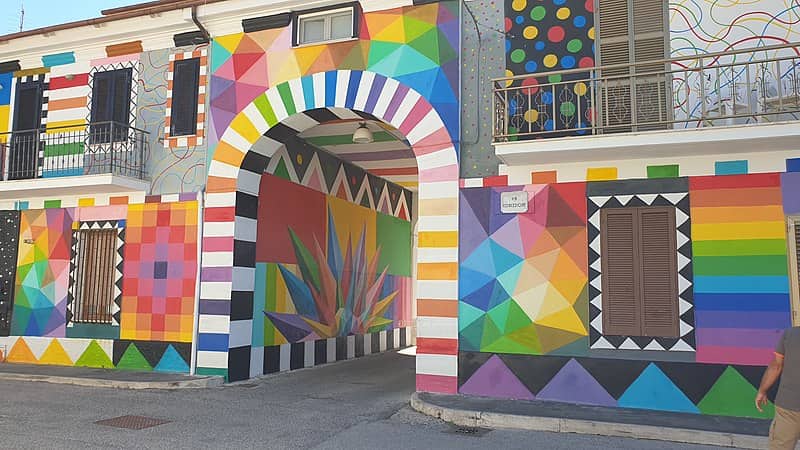
We leave the Marche region and arrive in Abruzzo. Here we find Aielli, a medieval village perched on a spur of limestone rock in L'Aquila's province. The town contains an extraordinary treasure trove of urban art thanks to the Borgo Universo street art festival, which combines the language of art with astronomy and local history.
Since 2017, artists from all over the world have taken turns to create 25 murals here, attracting thousands of people intrigued by the lively and colourful soul of this charming terrace on Marsica.
7. Molise: Campomarino, Santa Croce di Magliano and Civitacampomarano
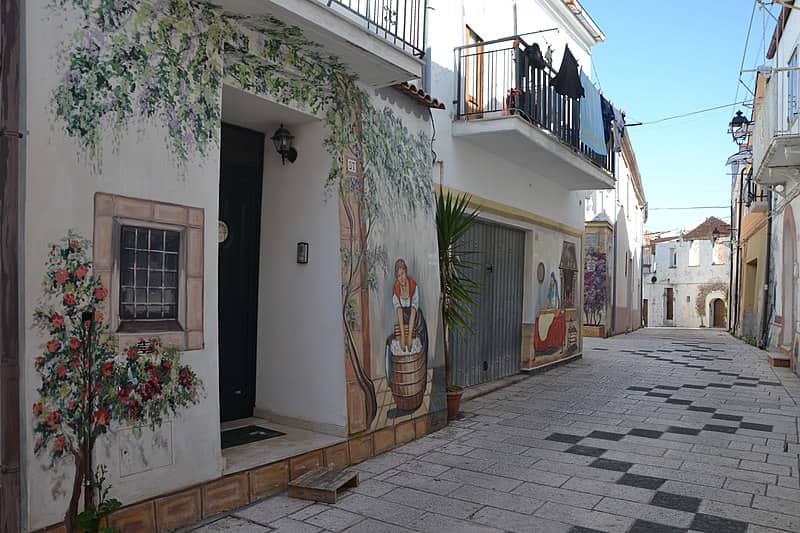
We travel to Molise and go to the province of Campobasso, where we find the village of Campomarino. The town retains the ancient Arbëreshe (Albanian population of Italy) culture, perched on a hill. Its narrow streets and panoramic views hide houses with amusing murals.
We remain in Molise but move on to Santa Croce di Magliano, with over 4,000 inhabitants and a street art project that combines art and social commitment. It all began with Marianna, the sculptor and painter Antonio Giordano's daughter (born in Santa Croce di Magliano). She created the Antonio Giordano Award, an urban art project aimed at disseminating the visual arts. Writers accepted the invitation from worldwide who came here to paint on the town's walls.
The last stop in Molise is the small village of Civitacampomarano, a cluster of perched houses, which hit the headlines thanks to the CVTà Street Fest, organised by artist Alice Pasquini. Here street artists redesigned the urban landscape of this charming corner of the province of Campobasso. The festival did not stop in 2020 either: the artists coordinated via Zoom to install new works during this edition.
6. Campania: Valogno, Bonito and Piano-Vetrale
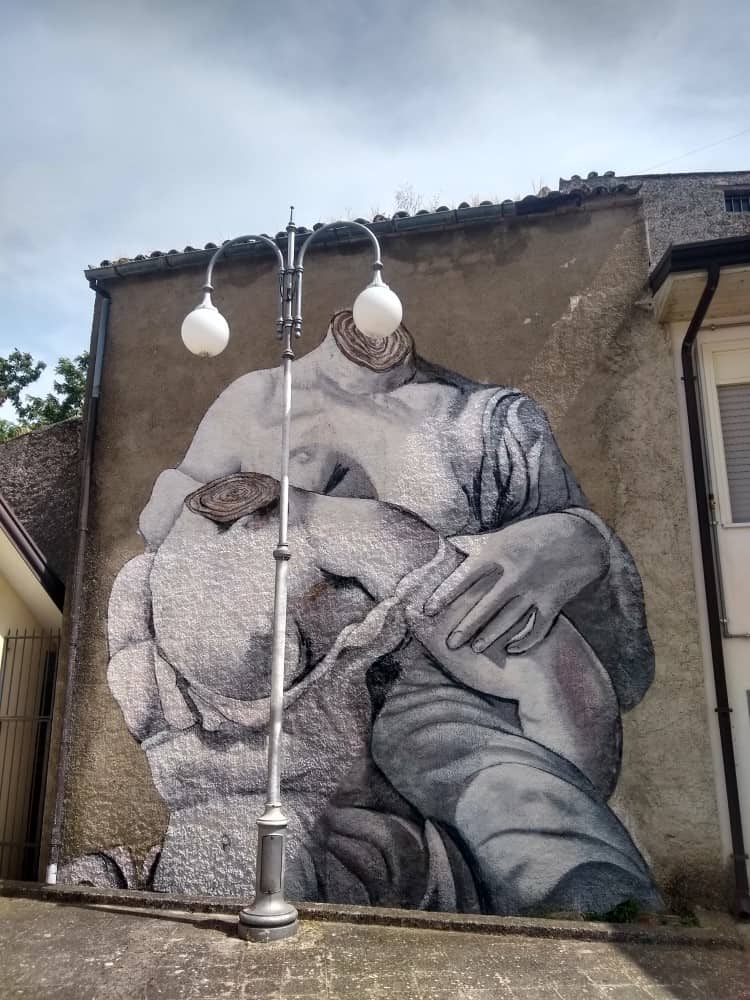
And now we come to Campania, where Naples alone has more than a hundred street artworks, but here we are talking about villages, and we want to present three of them to you: Valogno, Bonito and Piano-Vetrale.
In the province of Caserta is the village of Valogno, known as the Land of Murals and Fantasy. Between the 1960s and 1990s, more and more young people emigrated, gradually turning into a ghost town. In 2008, Giovanni Casale and his wife Dora Mesolla from Rome returned here, their native village. They wanted to make their dream come true: to self-finance the project I Colori del Grigio (The Colours of Grey), founding an association and colouring the streets of Vologno with 42 murals.
But let's leave the province of Caserta and go to Irpinia, to Bonito (in the area of Avellino), to be precise. Here, thanks to the intuition of the Boca Collective, the walls of the town centre have become canvases on which international street art artists have expressed their creativity. Among these graffiti, there is Genesis by Argentine artist Francisco Basoletti, recognised as one of the top three most beautiful works globally.
Finally, we move on to Cilento and discover Piano Vetrale, a hamlet of Orria with just 270 inhabitants. Its walls depict scenes of everyday rural life, fairy-tale characters, zodiac signs and popular traditions. The initiative originated in the 1970s, thanks to a happy intuition of the late Sicilian artist Pino Crisanti. The idea was by the local Pro Loco, who dedicated it to Paolo De Matteis, a painter born in Piano Vetrale and a pupil of Luca Giordano.
5. Apulia: Stornara, Mesagne and Grottaglie
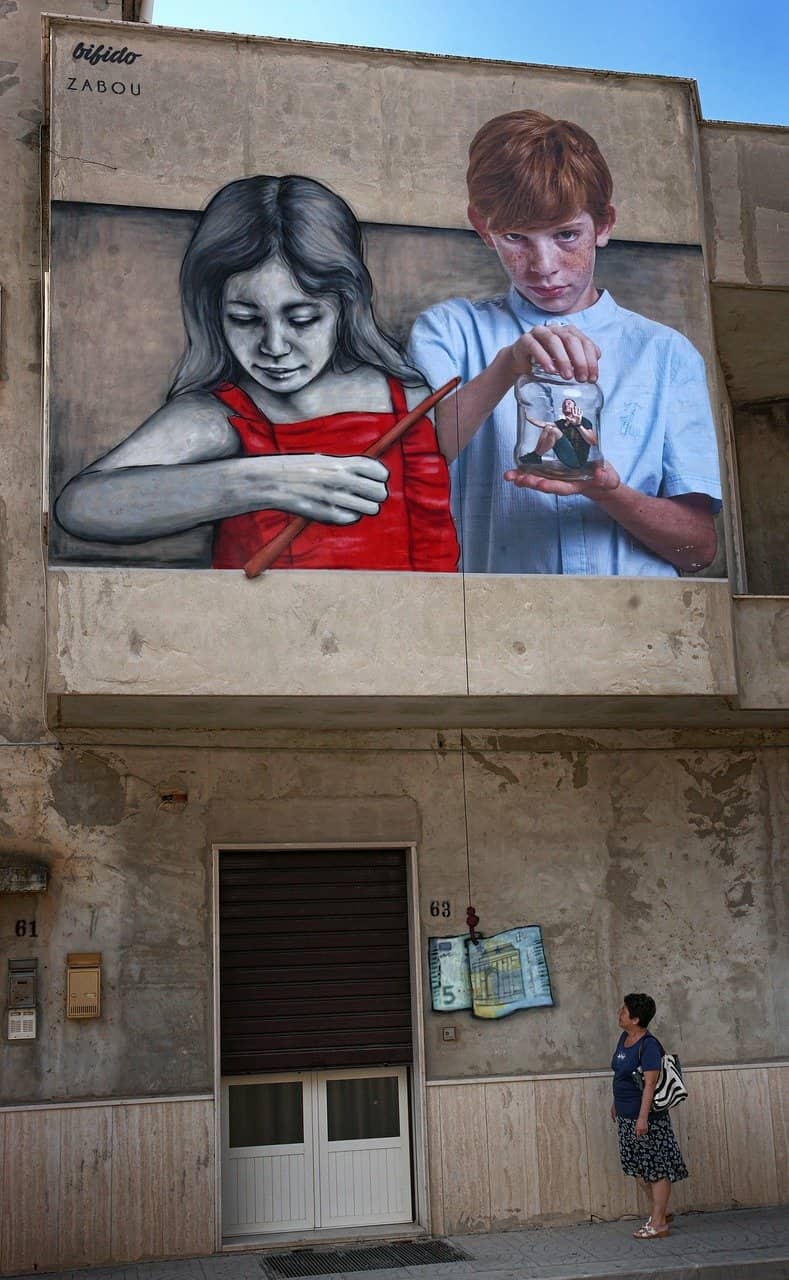
In Apulia, we come to Stornara. It is a small village in Foggia; it is home to many works of urban art thanks to the Stramurales Festival, thanks to its 52 artworks. The festival aims to bring the craft to places where it has never been and make a small village a tourist destination for art lovers. The murals depict Puglia's famous people, such as Lino Banfi and Renzo Arbore.
Moving on to the Brindisi area, we go to Mesagne. This small municipality was born Francesco Camillo Giorgino, the famous writer Millo, who painted the "peasant houses" in Via Galilei in his village. The aim is to revitalise these barracks built in the 1960s behind the municipal sports ground and turn them into an urban park.
Finally, we come to Grottaglie (in the province of Taranto), known as the Land of Ceramics. From 2008 to 2012, it hosted the FAME Festival: famous artists left their mark on the white walls for five years in this Salento village. These include the murals of artist Paolo Carriere, depicting favourite cartoon characters from the 1980s to the present day.
4. Basilicata: Stigliano, Gorgoglione and Sant’Angelo Le Fratte
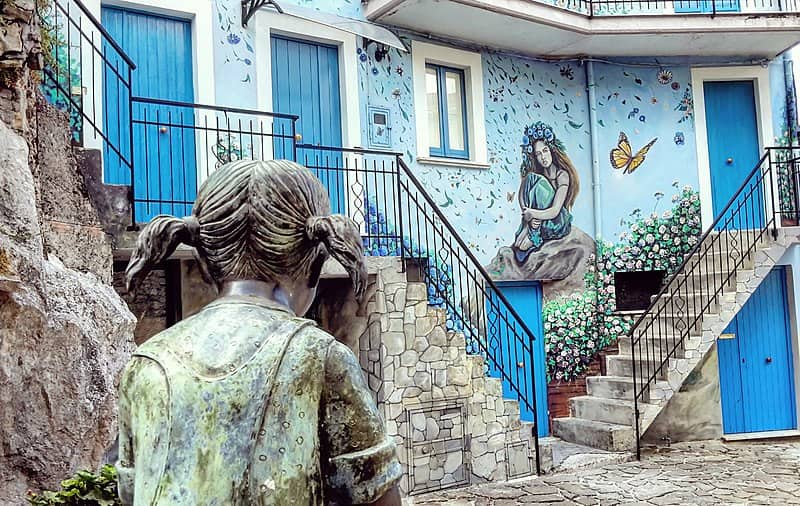
Let's leave Apulia and arrive in Basilicata. The small village of Stigliano (in the province of Matera) hosts the international AppARTEngo Festival. It was created to revitalise this town, historically the first capital of Basilicata and now at risk of depopulation. The village has an extraordinary historical heritage. Over the last five years, dozens of artists from all over the world have filled the streets and alleys with works of modern art, making it a veritable open-air art gallery.
Also in the province of Matera is Gorgoglione, a town known as the City of Stones. Here an art project entitled Art with and for Women took place, involving seven female artists from all over the world who created graffiti wholly dedicated to women.
Let's leave the Matera area for the province of Potenza, in Sant'Angelo Le Fratte. Since 1995, over 50 national and international artists have created around 150 murals and ten sculptures. Together with Satriano di Lucania and Savoia di Lucania, the village is part of Melandro, the most painted valley in Italy.
3. Calabria: Murals Opration in Diamante

We leave Basilicata and arrive in Calabria. On the Riviera dei Cedri we find Diamante. In 1981 the painter Nani Razetti created Operazione Murales. Artists came to the Calabrian town and created veritable works of art on the walls of the houses in the historic centre.
Walking around Diamante is like taking a journey from tradition to fantasy. On one of the walls of the town's Mother Church is one of the most famous mosaic murals, on which you can admire the history of the region.
2. Sicily: the independent cultural centre of Favara
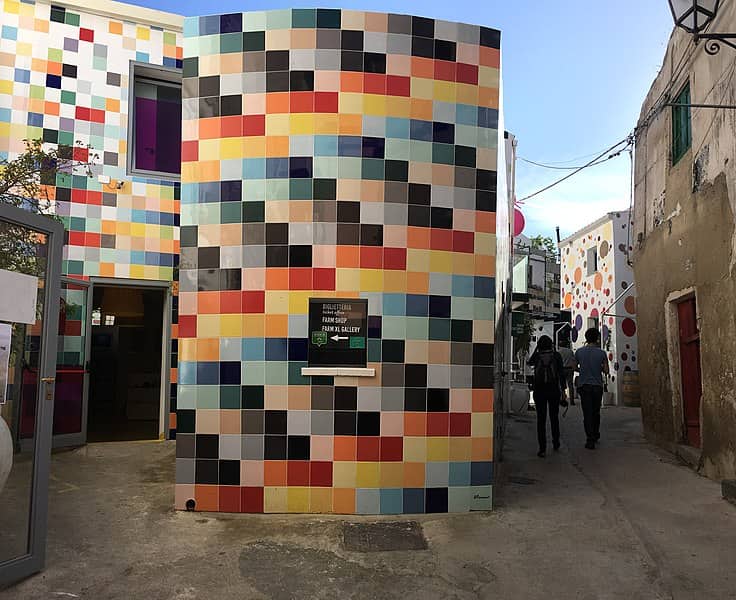
We cross the Strait and arrive in Sicily. In the province of Agrigento, the peripheral town of Favara, transformed into one of the most influential independent cultural centres in the contemporary art world and one of the most exuberant projects for the rethinking and rebirth of the town.
In 2010 a project was born that gave life to the dream of transforming an abandoned historical centre into a cultural and tourist attraction, subverting a town's identity associated with squatting and crime into a place of art and experimentation.
1. Sardinia: San Gavino Monreale, Fluminimaggiore and Orgosolo

Finally, we reach the island of Sardinia. Here we come to the Medio Capidano, in San Gavino Monreale, to be precise, a town known for its saffron cultivation and which has become a destination for street art enthusiasts. Among the artists who have painted its walls is Giorgio Casu "Jorghe", a Sardinian artist who emigrated to New York and returns every summer to give the town one of his works.
In the province of Carbonia-Iglesias, we find the small village of Fluminimaggiore. It has embellished its buildings with beautiful murals, which are admired by some 2,000 visitors every year.
Finally, our journey ends in Orgosolo (in the province of Nuoro), which tells its story through its walls. We recall the Pratobello Revolution among its murals: when the local shepherds opposed the national institutions against constructing a military base on their fields.
About the author
Written on 17/09/2021

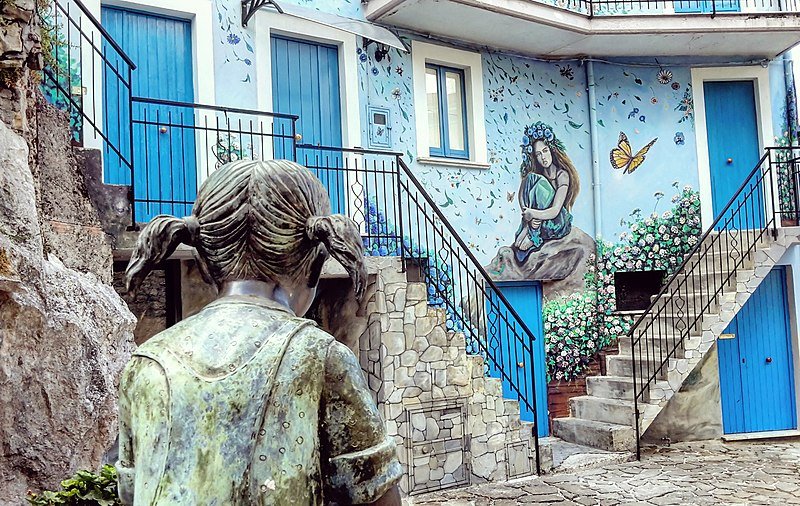

Ludovica Poliero
Great open-air museums that meet and blend with tradition. It has happened in some villages in Italy, where street art artists have given a rebirth and redevelopment to some forgotten places with their spray-painted works, reawakening visitors' and graffiti enthusiasts. We at Visit Italy propose a sort of itinerary: a journey from the north to the south of the boot, using spray cans and stencils.